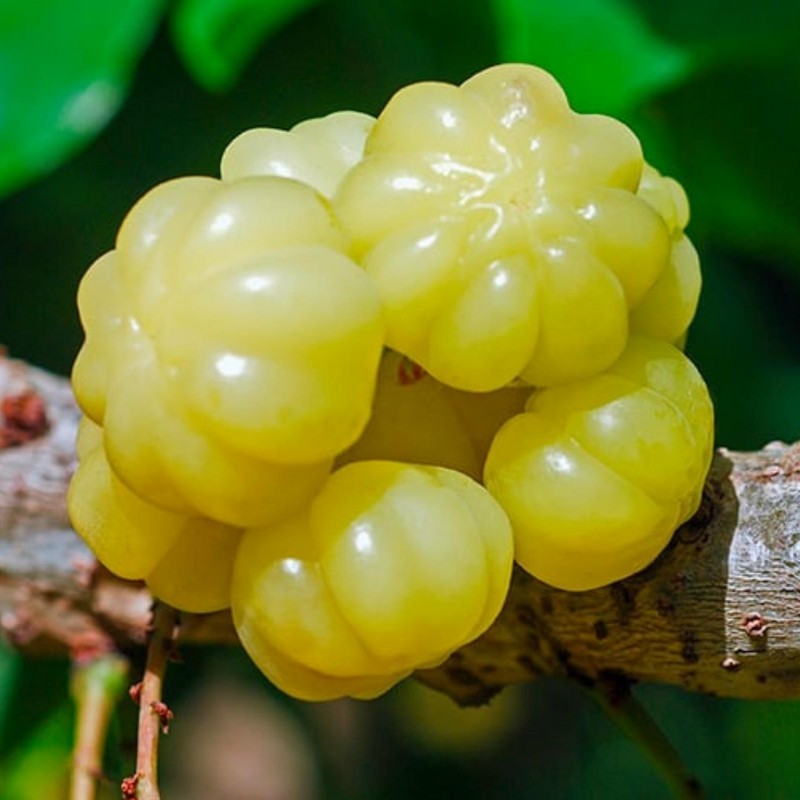
Star Gooseberry Seeds (Phyllanthus acidus)
Star Gooseberry Seeds (Phyllanthus acidus)
Price for Package of 5 seeds.
Phyllanthus acidus, known as the Otaheite gooseberry, Malay gooseberry, Tahitian gooseberry, Country gooseberry, Star gooseberry, Starberry, West India gooseberry, or simply Gooseberry tree, is one of the
Star Gooseberry Seeds (Phyllanthus acidus)
Price for Package of 5 seeds.
Phyllanthus acidus, known as the Otaheite gooseberry, Malay gooseberry, Tahitian gooseberry, Country gooseberry, Star gooseberry, Starberry, West India gooseberry, or simply Gooseberry tree, is one of the trees with edible small yellow berries fruit in the Phyllanthaceae family. Despite its name, the plant does not resemble the gooseberry, except for the acidity of its fruits. It tastes sour and tart.
Phyllanthus acidus is an intermediary between a shrub and tree, reaching 2 to 9 m (6½ to 30 ft) high. The tree's dense and bushy crown is composed of thickish, tough main branches, at the end of which are clusters of deciduous, greenish, 15-to-30-cm long branchlets. The branchlets bear alternate leaves that are ovate or lanceolate in form, with short petioles and pointed ends. The leaves are 2-7.5 cm long and thin, they are green and smooth on the upperside and blue-green on the underside. In general, the Otaheite gooseberry tree very much looks like the bilimbi tree.
The flowers can be male, female or hermaphrodite. They are small and pinkish and appear in clusters in 5-to-12.5-cm long panicles. Flowers are formed at leafless parts of the main branches, at the upper part of the tree. The fruits are numerous, oblate, with 6 to 8 ribs, and densely clustered. They are pale yellow or white, waxy, crisp and juicy, and very sour. 4 to 6 seeds are contained in a stone at the center of each fruit.
This tropical or subtropical species is found throughout Asia and also in the Caribbean region, Central and South America.
While its origin is uncertain, the species may have originated in Madagascar. It was found in other parts of South Asia early; according to Eduardo Quisumbing, it was brought to the Philippines in prehistoric times. It spread across the Indian Ocean to Réunion and Mauritius and crossed the Pacific to Hawaii. It expanded to the Caribbean in 1793, when William Bligh carried the plant from Timor to Jamaica.
The tree is common in Guam, Micronesia (where it is called ceremai or cerama), South Vietnam (called chùm ruột), Laos, northern Peninsular Malaysia (called cerme and cermai), and India (called - (Tamil-தமிழ்-[அரை நெல்லிக்காய்], chalmeri, harpharoi, [{Nellikai in kannada}], Harfi, Arunellikai, Abazhanga, Nellipuli, Usiri(Telugu-ఉసిరి), Khatamada, Arinelli, Bimbool, Arinellika, Kiru Nerle, Mara Nelli, Amla, Gihori (Manipuri), Nōṛa(Bengali-নোড়)[2][4] and rosavale (konkani language) in goa. It is still found in the Philippines (called iba in Tagalog and karmay in Ilokano), if not widely, and in Cambodia (called kantuet) and Thailand (called mayom). In Grenada, the fruit is called a damsel. In St. Lucia, the fruit is known as "see-wet". In the United States, it is found in Hawaii, and occasionally southern parts of Texas, Florida. It is also found in Puerto Rico (where the fruit is called grosella), Ecuador, El Salvador, Mexico, Colombia, Venezuela, Suriname (where it's called ronde birambi), US Virgin Islands, Peru and Brazil.
Names in other languages
அரை நெல்லிக்காய்(arainellikai, in Tamil-தமிழ்), ନରକୋଳି(narakoLi, in Odisha), Khmer: កន្ទួត (in Bangladesh) Orboroi, Grosella (in Puerto Rico), Raspberry (in Antigua and Barbuda), Jimbilin (in Jamaica), Damsel (in St Vincent and the Grenadines and Grenada), Sour Cherry (in Trinidad and Tobago), Karamay (in the Northern Philippines),Layuan (in the Bicol region of the Philippines), (Rata Nelli , Nelli Bilin in Sri lanka) Bangkiling (in the Southern Philippines), Cermai (in Brunei Darussalam, Indonesia and Malaysia), Goanbili (in Maldives), Grosella (in Belize), ဆီးျဖူသီး (in Myanmar), Guinda (in El Salvador), নোড়(Nōṛa, in West Bengal), Azedinha (in Cabo Verde), Groselha (in Brazil), มะยม [majom] (in Thailand) ,Tjerimée (in Dutch) and రాచ ఉసిరి, నక్షత్ర ఉసిరి (in Telugu)
Cultivation and human use
The Otaheite gooseberry prefers moist soil. It can be cultivated in a variety of ways—budding, cutting and air-layering—in addition to the usual seed growth. The tree is cultivated for its ornamental value, but also for food and medicinal purposes. While it produces some fruit throughout the year, it is mainly harvested in January except in South India, where it bears crops in April–May and again in August–September. As the fruit does not soften when ripe, it is harvested when the fruit begins to drop.
Various parts of the plant are used for food. In India and Indonesia, the cooked leaves are eaten. While the fruit is eaten fresh, and is sometimes used as flavoring for other dishes in Indonesia, it is generally regarded as too tart to eat by itself in its natural form and is processed further. It is candied in sugar or pickled in salt, used in chutney, relish or preserves. In the Philippines, it is used to make vinegar as well as eaten raw, soaked in salt or vinegar-salt solution and sold along the roadside. It is candied as well, usually stored in jars with syrup. They make these into a syrup in Malaysia. Liberally sugared, it is also used to make fruit juice. In Thailand it is used as an ingredient to make Som tam, to make pickled, boil in syrup (Ma-Yom Chuam).
The plant is also used medicinally. The peppered leaves are used to make a poultice to treat sciatica, lumbago and rheumatism (but have been observed to cause low blood pressure when combined with nitrates), while the seeds are used as a cathartic and the root, if prepared with care, as a purgative. The syrup is used to medicate the stomach, and in India the fruit is eaten as a blood-enhancer for the liver. P. acidus contains 4-hydroxybenzoic acid, caffeic acid,[8] adenosine, kaempferol and hypogallic acid.
While the wood is strong and durable if properly treated, the tree is not large and is rarely harvested for wood. In India, the root bark is sometimes used for tanning.
| HEIRLOOM ? | Yes |
|---|---|
| Organic Seeds ? | Organic Seeds |
| Edible ? | Edible |
| Perennial ? | Perennial plant : Yes |
| Válogatott magok? | Válogatott magvak |
| Suitable for growing in flower pot ? | Suitable for pot: Yes |
| Plant height ? | 5-10 m |
| Origin of seeds ? | Seeds imported from: Thailand |
| Medicinal Plant ? | Medicinal Plant: Yes |


Your review appreciation cannot be sent
Report comment
Report sent
Your report cannot be sent
Írd meg véleményedet
Review sent
Your review cannot be sent
🌍 Globális szállítás az EU-ból
Világszerte szállítunk az Európai Unióból ajánlott küldeményként, átvételi visszaigazolással.
📦 Csomagkövetés
A csomagod követéséhez jelentkezz be a fiókodba, majd menj a Rendeléstörténet > Részletek menüpontra, ahol megtalálod a követési számot.
Nemzetközi követés: 17Track
RGxxxxxxHR típusú számok esetén: Posta.hr követés
🕒 Kérjük, várj legalább 24 órát a feladás után, hogy a követési adatok elérhetővé váljanak.
⚠️ Fontos tudnivalók
Utánvét nem elérhető.
Rendszeresen ellenőrizd a spam vagy kéretlen mappát az e-mail fiókodban az értesítésekért.
Kérjük, kizárólag a weboldalunkon található kapcsolati űrlapot használd.
Közvetlen e-mailekre nem biztos, hogy válaszolunk.
📱 Telefonszám megadása kötelező
Rendeléskor kötelező megadni a mobiltelefonszámodat az országkóddal együtt.
Példa: +36 30 123 4567
🚚 Szállítási feltételek
A nyomon követett csomag átvételekor átvételi aláírás szükséges.
Ne rendelj, ha:
postafiókba szeretnéd a csomagot
nem leszel otthon a kézbesítéskor
a csomagot a szomszédnak szeretnéd átadni (❌ ez nem lehetséges)
📬 Ha postafiók címet adsz meg, és a csomag elveszik, nem jár visszatérítés.
↩️ Csomag visszaküldése és újraküldés
Ha bármilyen okból visszaküldik a csomagot:
Visszaküldési díjat kell fizetned: 2 €
Valamint az újraküldés költségét is
⏱ Késések és nyomon követés
Ha a csomag még mindig a feladónál szerepel a követésben, az azt jelenti, hogy úton van.
A legfrissebb információkért keresd meg a helyi postahivatalt a követési számmal.
Nem vagyunk postaszolgáltató, így a csomagot nem tudjuk helyetted követni.
Nem vállalunk felelősséget a szállítás időtartamáért.
🔍 Eltűnt csomag ügyében vizsgálatot csak 30 nappal a feladás után indíthatunk.
✈️ Szállítási opciók
| Szállítás típusa | Feldolgozási idő | Biztosítás | Lehetséges késések | Megjegyzés |
|---|---|---|---|---|
| Standard | 7–10 munkanap | ❌ | 7–14 munkanap | Legolcsóbb opció |
| Prioritás | 1–7 munkanap | ❌ | 3–10 munkanap | Prioritásos feldolgozás – nem feltétlenül gyorsabb szállítás |
| Biztosított | 1–7 munkanap | ✅ | 3–10 munkanap | Visszatérítés elvesztés esetén (max. 150 € értékig) |
🕒 Várható szállítási idő:
Európai Unión belül: 3–20 munkanap
Világszerte: 5–30 munkanap
USA példák: 27, 22, 19, 17, 13 nap
💳 Fizetési módok
💶 Banki átutalás (SEPA / IBAN / SWIFT-BIC)
A fizetés leírásában kötelező megadni a rendelési számot (pl. SGS-19811702).
Ha hiányzik ez az adat, késedelmet vagy rendelés törlést okozhat.
Ha a befizetés nem érkezik meg 7 napon belül, a rendelést automatikusan töröljük.
🅿️ PayPal
Csak euróban történő fizetést fogadunk el PayPal-on keresztül.
Kérjük, a fizetéskor válaszd az eurót mint pénznemet.
💳 Bankkártyás fizetés
Kártyás fizetés a weboldalunkon keresztül: Exotic Seeds Store
Elfogadott kártyák: Visa, MasterCard, American Express, Diners Club, UnionPay, JCB, Discover stb.
💡 A vásárló viseli az esetleges tranzakciós díjakat.
Kérjük, küldd el a fizetés igazolását a gyorsabb feldolgozás érdekében.
📅 Egyéb információk
Hétvégén (szombat, vasárnap) nem dolgozunk fel rendeléseket és nem szállítunk.
Mindig olvasd el a fontos közleményeket a weboldalunkon (ünnepnapok, speciális feltételek stb.).
📫 Fontos:
Ne küldj közvetlen e-mailt nekünk. Csak a weboldalunkon lévő kapcsolati űrlapot használd.
Related Products



















